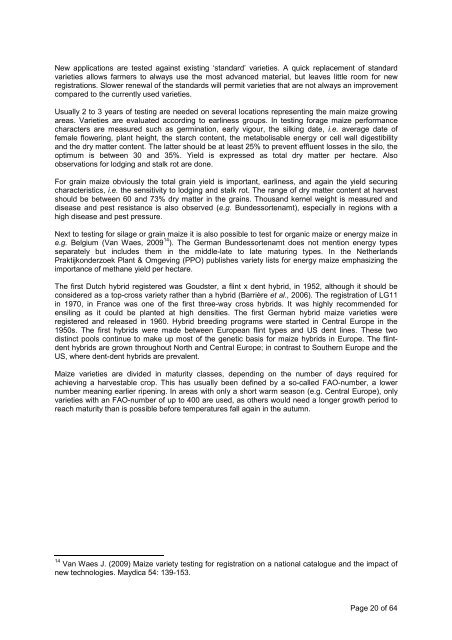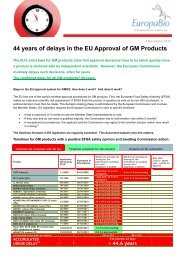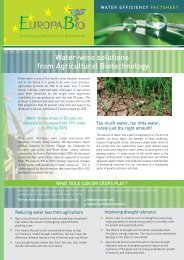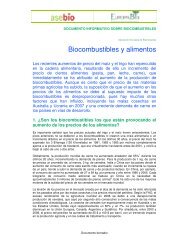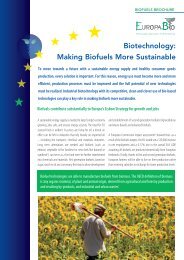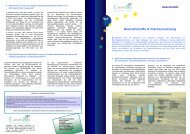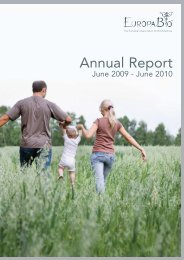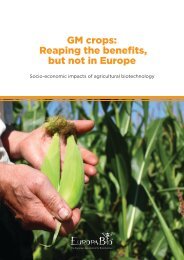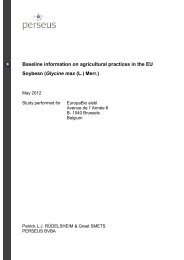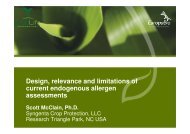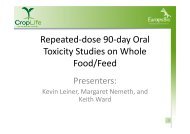Baseline information on agricultural practices in the EU ... - Europabio
Baseline information on agricultural practices in the EU ... - Europabio
Baseline information on agricultural practices in the EU ... - Europabio
You also want an ePaper? Increase the reach of your titles
YUMPU automatically turns print PDFs into web optimized ePapers that Google loves.
New applicati<strong>on</strong>s are tested aga<strong>in</strong>st exist<strong>in</strong>g ‘standard’ varieties. A quick replacement of standard<br />
varieties allows farmers to always use <strong>the</strong> most advanced material, but leaves little room for new<br />
registrati<strong>on</strong>s. Slower renewal of <strong>the</strong> standards will permit varieties that are not always an improvement<br />
compared to <strong>the</strong> currently used varieties.<br />
Usually 2 to 3 years of test<strong>in</strong>g are needed <strong>on</strong> several locati<strong>on</strong>s represent<strong>in</strong>g <strong>the</strong> ma<strong>in</strong> maize grow<strong>in</strong>g<br />
areas. Varieties are evaluated accord<strong>in</strong>g to earl<strong>in</strong>ess groups. In test<strong>in</strong>g forage maize performance<br />
characters are measured such as germ<strong>in</strong>ati<strong>on</strong>, early vigour, <strong>the</strong> silk<strong>in</strong>g date, i.e. average date of<br />
female flower<strong>in</strong>g, plant height, <strong>the</strong> starch c<strong>on</strong>tent, <strong>the</strong> metabolisable energy or cell wall digestibility<br />
and <strong>the</strong> dry matter c<strong>on</strong>tent. The latter should be at least 25% to prevent effluent losses <strong>in</strong> <strong>the</strong> silo, <strong>the</strong><br />
optimum is between 30 and 35%. Yield is expressed as total dry matter per hectare. Also<br />
observati<strong>on</strong>s for lodg<strong>in</strong>g and stalk rot are d<strong>on</strong>e.<br />
For gra<strong>in</strong> maize obviously <strong>the</strong> total gra<strong>in</strong> yield is important, earl<strong>in</strong>ess, and aga<strong>in</strong> <strong>the</strong> yield secur<strong>in</strong>g<br />
characteristics, i.e. <strong>the</strong> sensitivity to lodg<strong>in</strong>g and stalk rot. The range of dry matter c<strong>on</strong>tent at harvest<br />
should be between 60 and 73% dry matter <strong>in</strong> <strong>the</strong> gra<strong>in</strong>s. Thousand kernel weight is measured and<br />
disease and pest resistance is also observed (e.g. Bundessortenamt), especially <strong>in</strong> regi<strong>on</strong>s with a<br />
high disease and pest pressure.<br />
Next to test<strong>in</strong>g for silage or gra<strong>in</strong> maize it is also possible to test for organic maize or energy maize <strong>in</strong><br />
e.g. Belgium (Van Waes, 2009 14 ). The German Bundessortenamt does not menti<strong>on</strong> energy types<br />
separately but <strong>in</strong>cludes <strong>the</strong>m <strong>in</strong> <strong>the</strong> middle-late to late matur<strong>in</strong>g types. In <strong>the</strong> Ne<strong>the</strong>rlands<br />
Praktijk<strong>on</strong>derzoek Plant & Omgev<strong>in</strong>g (PPO) publishes variety lists for energy maize emphasiz<strong>in</strong>g <strong>the</strong><br />
importance of methane yield per hectare.<br />
The first Dutch hybrid registered was Goudster, a fl<strong>in</strong>t x dent hybrid, <strong>in</strong> 1952, although it should be<br />
c<strong>on</strong>sidered as a top-cross variety ra<strong>the</strong>r than a hybrid (Barrière et al., 2006). The registrati<strong>on</strong> of LG11<br />
<strong>in</strong> 1970, <strong>in</strong> France was <strong>on</strong>e of <strong>the</strong> first three-way cross hybrids. It was highly recommended for<br />
ensil<strong>in</strong>g as it could be planted at high densities. The first German hybrid maize varieties were<br />
registered and released <strong>in</strong> 1960. Hybrid breed<strong>in</strong>g programs were started <strong>in</strong> Central Europe <strong>in</strong> <strong>the</strong><br />
1950s. The first hybrids were made between European fl<strong>in</strong>t types and US dent l<strong>in</strong>es. These two<br />
dist<strong>in</strong>ct pools c<strong>on</strong>t<strong>in</strong>ue to make up most of <strong>the</strong> genetic basis for maize hybrids <strong>in</strong> Europe. The fl<strong>in</strong>tdent<br />
hybrids are grown throughout North and Central Europe; <strong>in</strong> c<strong>on</strong>trast to Sou<strong>the</strong>rn Europe and <strong>the</strong><br />
US, where dent-dent hybrids are prevalent.<br />
Maize varieties are divided <strong>in</strong> maturity classes, depend<strong>in</strong>g <strong>on</strong> <strong>the</strong> number of days required for<br />
achiev<strong>in</strong>g a harvestable crop. This has usually been def<strong>in</strong>ed by a so-called FAO-number, a lower<br />
number mean<strong>in</strong>g earlier ripen<strong>in</strong>g. In areas with <strong>on</strong>ly a short warm seas<strong>on</strong> (e.g. Central Europe), <strong>on</strong>ly<br />
varieties with an FAO-number of up to 400 are used, as o<strong>the</strong>rs would need a l<strong>on</strong>ger growth period to<br />
reach maturity than is possible before temperatures fall aga<strong>in</strong> <strong>in</strong> <strong>the</strong> autumn.<br />
14 Van Waes J. (2009) Maize variety test<strong>in</strong>g for registrati<strong>on</strong> <strong>on</strong> a nati<strong>on</strong>al catalogue and <strong>the</strong> impact of<br />
new technologies. Maydica 54: 139-153.<br />
Page 20 of 64


